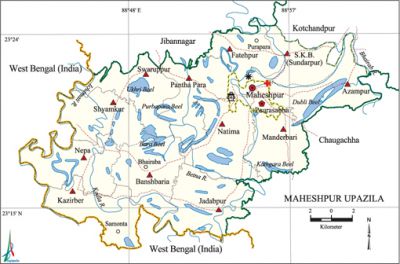Maheshpur Upazila
Maheshpur Upazila (jhenaidah district) area 405.44 sq km, located in between 23°13' and 23°25' north latitudes and in between 88°42' and 89°02' east longitudes. It is bounded by jibannagar and kotchandpur upazilas on the north, chaugachha upazila and west bengal state of India on the south, Chaugachha upazila on the east, West Bengal of India on the west.
Population Total 296248; male 152058, female 144190; Muslim 284029, Hindu 12048, Buddhist 95 and others 78.
Water bodies Main rivers: ichamati, Kodla, betna, bhairab; Ukhri, Purbapara, Bara, Kathgara and Dubli' beels are notable.
Administration Maheshpur Thana was turned into an upazila in 1983.
| Upazila | ||||||||
| Municipality | Union | Mouza | Village | Population | Density (per sq km) | Literacy rate (%) | ||
| Urban | Rural | Urban | Rural | |||||
|
1 |
12 |
150 |
196 |
23100 |
273148 |
731 |
50.5 |
43.1 |
| Municipality | ||||||||
|
Area (sq km) |
Ward |
Mahalla |
Population |
Density (per sq km) |
Literacy rate (%) | |||
|
21.34 |
9 |
16 |
23100 |
2014 |
50.5 | |||
| Union | ||||||||
| Name of union and GO code | Area (acre) | Population | Literacy rate (%) | |||||
| Male | Female | |||||||
|
Azampur10 |
7935 |
10691 |
9934 |
45.51 | ||||
|
S.K.B. 83 |
5639 |
7989 |
7506 |
50.67 | ||||
|
Kazirber 29 |
8756 |
15135 |
14498 |
36.99 | ||||
|
Natima 53 |
9281 |
11713 |
11049 |
43.06 | ||||
|
Nepa 59 |
8486 |
13240 |
12567 |
41.70 | ||||
|
Pantha Para 65 |
8485 |
8736 |
8336 |
44.32 | ||||
|
Fatehpur 17 |
7404 |
11096 |
10478 |
48.57 | ||||
|
Banshbaria 11 |
9159 |
13867 |
13255 |
39.57 | ||||
|
Manderbari 35 |
7250 |
13016 |
12219 |
50.67 | ||||
|
Jadabpur 23 |
9664 |
12801 |
12439 |
42.77 | ||||
|
Shyamkur 77 |
8310 |
11950 |
11273 |
38.56 | ||||
|
Swaruppur 89 |
8025 |
9955 |
9405 |
38.38 | ||||
Source Bangladesh Population Census 2001, Bangladesh Bureau of Statistics.
Archaeological heritage and relics Buro Shiva Mandir (Maheshwar), Rajballav Mandir, Sundalpur Zamindar Bari, Khalishpur Neel Kuthi, tomb of Bhalai Shah, Sreepat Mandir.
History of the War of Liberation In 1971 encounters were held between the freedom fighters and the Pak army at Hushorkhali, Babur Bagan, Ujjalpur, Jadabpur, Dattanagar and Puro Para. In the encounter at Hushorkhali a number of Pak soldiers were killed and so were two freedom fighters; besides one freedom fighter was captured by the Pak army. In the encounter at Dattanagar a number of Pak soldiers were killed and one freedom fighter was wounded.'

Marks of the War of Liberation Mass killing site 1 (Shaheb Dari); memorial monument 1 (Maheshpur High School premises).
Religious institutions Mosque 350, temple 30. Noted religious institutions: Maheshpur Jami Mosque, Shiva Mandir, Sreepat Mandir.
Literacy rate and educational institutions Average literacy 43.7%; male 47%, female 40.1%. Educational institutions: college 9, secondary school 44, primary school 134, community school 23, madrasa 25. Noted educational institutions: Maheshpur Government Degree College (1985), Maheshpur High School (1863), Khalishpur Multilateral Secondary School (1869), Maheshpur Secondary Girls' School (1976), Baichitala Islamia Dakhil Madrasa (1922), Natima' Senior Madrasa (1974).
Newspapers and periodicals Weekly: Simanta Bani; periodical: Chetona, Khanakal.
Cultural organisations Library 2, club 25, cinema hall 3, theatre stage 1, theatre group 5, press club 1.
Main sources of income Agriculture 74.79%, non-agricultural labourer 2.49%, commerce 12%, transport and communication 2.26%, service 2.71%, construction 0.58%, religious service 0.09%, rent and remittance 0.28% and others 4.80%.
Ownership of agricultural land Landowner 57.64%, landless 42.36%; agricultural landowner: urban 45.22% and rural 58.69%.
Main crops Paddy, jute, wheat, sugarcane, cotton, nut, onion, garlic, tomato, potato, vegetables.
Extinct or nearly extinct crops Barley, khesari, gram, arahar.
Main fruits Mango, jackfruit, banana, blackberry, papaya, coconut, star apple, watermelon, date.
Fisheries, dairies and poultries Dairy 21, poultry 46.
Communication facilities Pucca road 142 km, semi-pucca road 57 km, mud road 364 km; waterway 4 nautical miles.
Extinct or nearly extinct traditional transport Palanquin, horse carriage, bullock cart.
Noted manufactories Ice factory, welding factory.
Cottage industries Weaving, wood work, bamboo work.
Hats, bazars and fairs Hats and bazars are 12, fairs 3, most noted of which are Khalishpur Hat, Purapara Hat, Talsa Hat, Shyamkur Hat, Jinnanagar Hat, Bhairaba Hat, Samanta Hat, Belemat Hat, Fatehpur Baishakhi Mela and Maheshpur Durga Puja Mela.
''Main exports ' Banana, jackfruit, date molasses, potato, vegetables.
Access to electricity All the wards and unions of the upazila are under rural electrification net-work. However 13.66% of the dwelling households have access to electricity.
Sources of drinking water Tube-well 95.31%, tap 1.10%, pond 0.13% and others 3.46%.
Sanitation 10.78% (rural 10.10% and urban 18.81%) of dwelling households of the upazila use sanitary latrines and 55.02% (rural 54.78% and urban 57.93%) of dwelling households use non-sanitary latrines; 34.20% of households do not have latrine facilities.
Health centres Upazila health complex 1, satellite clinic 4, family planning clinic 11, community clinic 36, clinic 8, upazila family planning centre 1, union family planning centre 13.
Natural disasters Heavy water fall from the hill on 9 September 2009 caused serious flood in the region; it also caused heavy damages to semi-pucca settlements and crops of the upazila.
NGO activities Operationally important NGOs are brac, asa, proshika,' Srijani, Jagarani Chakra, Ahsania Mission. [Nasir Uddin]
References Bangladesh Population Census 2001, Bangladesh Bureau of Statistics; Cultural survey report of Maheshpur Upazila 2007.
